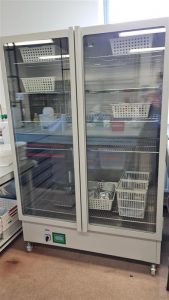We are pleased to announce that we have now completed the energy saving measurements from our first Salix grant-funded project – upgrading the existing lab drying ovens in operation across our Whiteknights campus. Drying ovens are typically used to dry a variety of equipment including glassware (test tubes, etc.) and instruments but they can also be used for general purpose warming. The upgrades have produced better energy savings than predicted, and we can expect this project to have a payback period of 5 years.
Why were the lab drying ovens upgraded?
Most of the previous drying ovens in operation were over 30 years old with poor insulation, making them very inefficient and costly. The poor insulation also caused overheating in the labs, which is another expense the new upgrades have helped to reduce.
The previous drying cabinets also had minimal controls due to their age, whereas the new drying ovens have digital controls allowing staff and students to easily set the temperature, timer, and even auto start/stop times.

The savings so far…
Six different models of drying ovens were selected for the upgrades, with a total of 24 drying ovens being delivered and installed in our labs. These range from big double drying cabinets to drying ovens small enough to sit on the lab work benches.
For us to accurately measure the savings produced by the upcoming upgrades, meters were installed onto the old drying cabinets to accurately measure their energy consumption in real-time. The recorded energy readings acted as our baseline to compare the energy consumption of the new drying ovens.
Once the new drying ovens were installed, meters were installed for a short period, so that accurate energy consumption measures could be recorded. We have seen savings from the drying ovens range from 48% to 91% depending on the model!

We have measured the total cumulative energy savings of the drying ovens annually as 76,958 kWh, which is the equivalent of removing 26.5 houses from the national grid*. This is an overall saving of 67% compared to the baseline figures. The carbon savings are equally impressive, with the drying ovens expected to save 18 tonnes CO2e (carbon dioxide equivalent) annually. In other terms, this is the equivalent of removing 8 cars from the road*. The total monetary savings of the project are also notable. Using electricity prices charged today, we could expect to save £11,698 per annum.
As a result of realising the good carbon and financial savings this project has produced, we decided to replace a further 8 drying ovens within the University using internal funds. This means that we have now upgraded every drying oven at the University!
While perhaps not the most high-profile project, the impact of the upgrades should not be understated, and are a vital part of the University’s ongoing work to reduce its carbon footprint. To read the full drying oven report click here.
To learn more about the other Salix projects underway, you can read the introductory article here.
*Typical Domestic Consumption Values (TDCVs) are industry standard values for the annual gas and electricity usage of a typical domestic consumer and the 2020 figure released by Ofgem is 2,900 kWh
*BEIS medium petrol car figure is 0.30029 kgCO2e per mile, Department for Transport (2019) state the average miles a car is driven annually is 7,400 miles.

